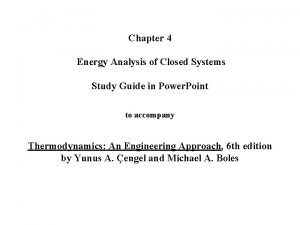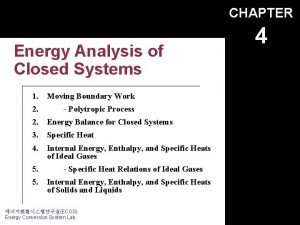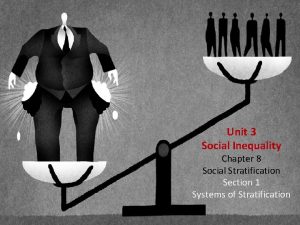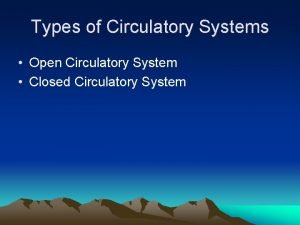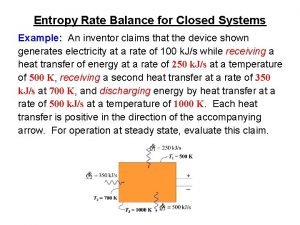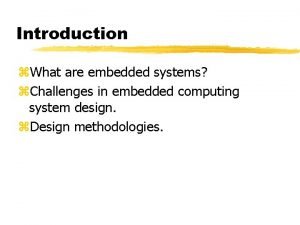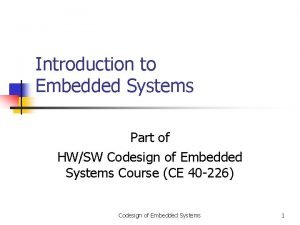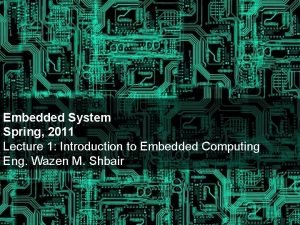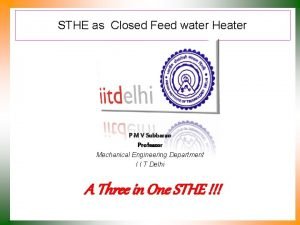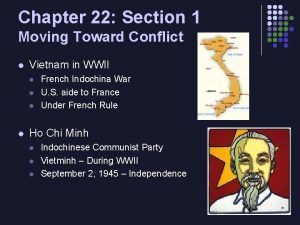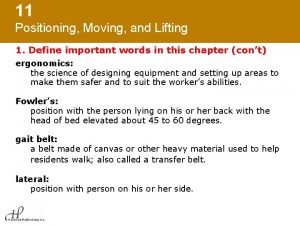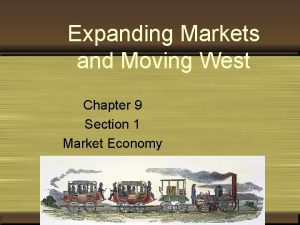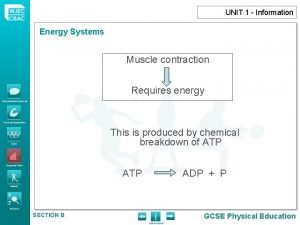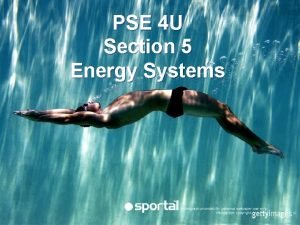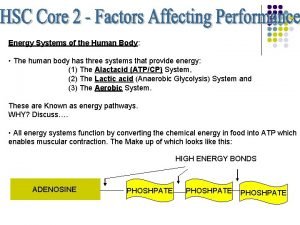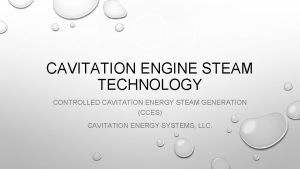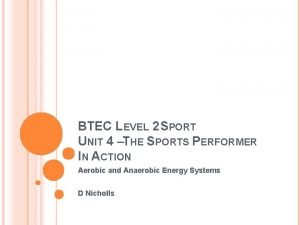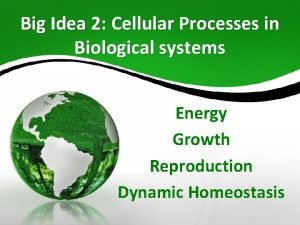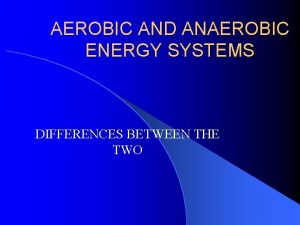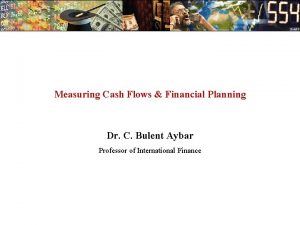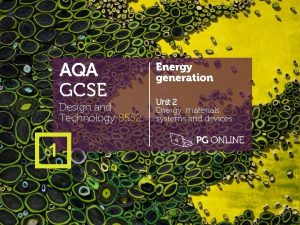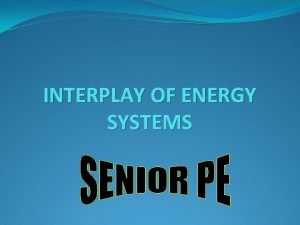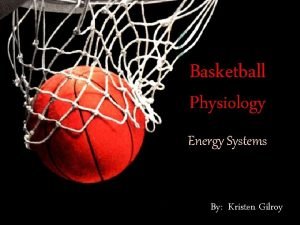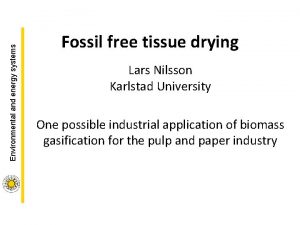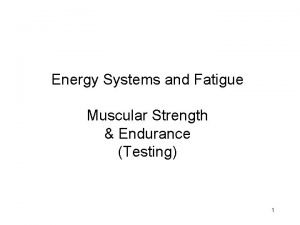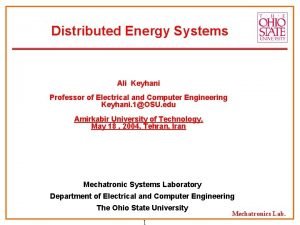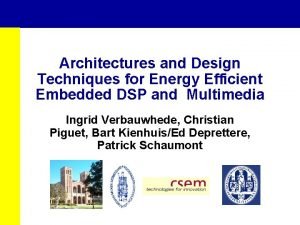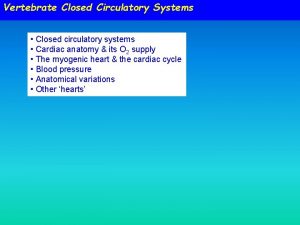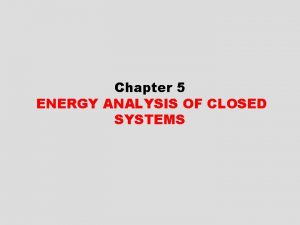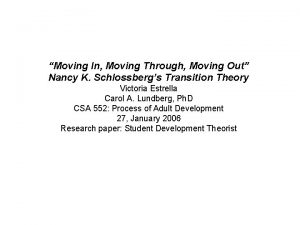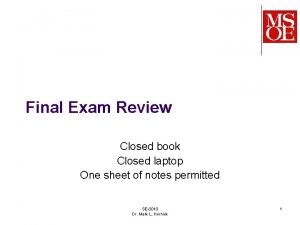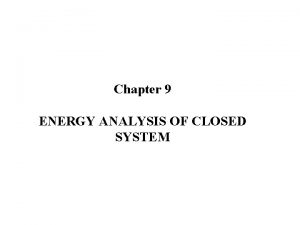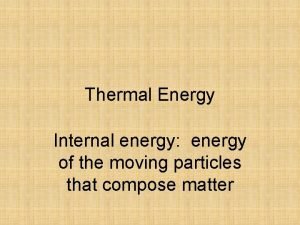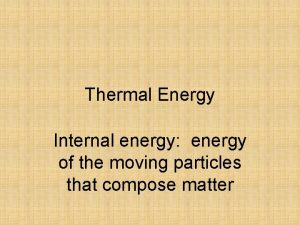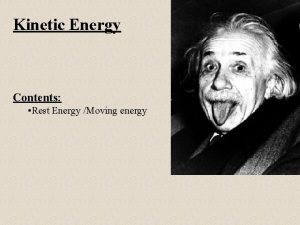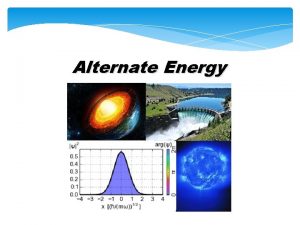CHAPTER Energy Analysis of Closed Systems 1 Moving
































































- Slides: 64

CHAPTER Energy Analysis of Closed Systems 1. Moving Boundary Work 2. - Polytropic Process 2. Energy Balance for Closed Systems 3. Specific Heat 4. Internal Energy, Enthalpy, and Specific Heats of Ideal Gases 5. 5. 4 - Specific Heat Relations of Ideal Gases Internal Energy, Enthalpy, and Specific Heats of Solids and Liquids 에너지변환시스템연구실(ECOS) Energy Conversion System Lab. Chung H. Jeon

4 -1 Moving Boundary Work 에너지변환시스템연구실(ECOS) Energy Conversion System Lab. l Work is energy expended when a force acts through a displacement. l Boundary work occurs because the mass of the substance contained within the system boundary causes a force to act on the boundary surface and make it move. l Boundary work is done by the steam on the piston. 2 Chung H. Jeon

l Since the work is process dependent, the differential of boundary work Wb l The boundary work is equal to the area under the process curve plotted on the pressure-volume diagram. l. P is the absolute pressure and is always positive. - When d. V is positive, Wb is positive. - When d. V is negative, Wb is negative. 에너지변환시스템연구실(ECOS) Energy Conversion System Lab. 3 Chung H. Jeon

l Since the areas under different process curves on a P-V diagram are different, the boundary work for each process will be different. l The figure shows that each process gives a different value for the boundary work. 에너지변환시스템연구실(ECOS) Energy Conversion System Lab. 4 Chung H. Jeon

Some Typical Processes Constant volume l If the volume is held constant, d. V = 0, and the boundary work equation becomes If the working fluid is an ideal gas, what will happen to the temperature of the gas during this constant volume process? 에너지변환시스템연구실(ECOS) Energy Conversion System Lab. 5 Chung H. Jeon

Constant pressure l If the pressure is held constant, the boundary work equation becomes For the constant pressure process shown above, is the boundary work positive or negative and why? 에너지변환시스템연구실(ECOS) Energy Conversion System Lab. 6 Chung H. Jeon

Constant temperature, ideal gas l If the temperature of an ideal gas system is held constant, then the equation of state provides the pressure-volume relation Then, the boundary work is Note: The above equation is the result of applying the ideal gas assumption for the equation of state. For real gases undergoing an isothermal (constant temperature) process, the integral in the boundary work equation would be done numerically. 에너지변환시스템연구실(ECOS) Energy Conversion System Lab. 7 Chung H. Jeon

The polytropic process l The polytropic process is one in which the pressure-volume relation is given as l The exponent n may have any value from minus infinity to plus infinity depending on the process. Some of the more common values are given below. Process Constant pressure Constant volume Isothermal & ideal gas Adiabatic & ideal gas Exponent n 0 1 k = CP/CV Here, k is the ratio of the specific heat at constant pressure CP to specific heat at constant volume CV. 에너지변환시스템연구실(ECOS) Energy Conversion System Lab. 8 Chung H. Jeon

에너지변환시스템연구실(ECOS) Energy Conversion System Lab. 9 Chung H. Jeon

l The boundary work done during the polytropic process is found by substituting the pressure-volume relation into the boundary work equation. l For an ideal gas under going a polytropic process, the boundary work is Notice that the results we obtained for an ideal gas undergoing a polytropic process when n = 1 are identical to those for an ideal gas undergoing the isothermal process. 에너지변환시스템연구실(ECOS) Energy Conversion System Lab. 10 Chung H. Jeon

Example Three kilograms of nitrogen gas at 27 C and 0. 15 MPa are compressed isothermally to 0. 3 MPa in a piston-cylinder device. Determine the minimum work of compression, in k. J. System: Nitrogen contained in a piston-cylinder device. Process: Constant temperature System Boundary Nitrogen gas 2 P Wb 1 V P-V DIAGRAM for T = CONSTANT Property Relation: Check the reduced temperature and pressure for nitrogen. The critical state properties are found in Table A-1. 에너지변환시스템연구실(ECOS) Energy Conversion System Lab. 11 Chung H. Jeon

l Since PR<<1 and T>2 Tcr, nitrogen is an ideal gas, and we use the ideal gas equation of state as the property relation. Work Calculation: 에너지변환시스템연구실(ECOS) Energy Conversion System Lab. 12 Chung H. Jeon

l For an ideal gas in a closed system (mass = constant), we have l Since the R's cancel, we obtain the combined ideal gas equation. Since T 2 = T 1, 에너지변환시스템연구실(ECOS) Energy Conversion System Lab. 13 Chung H. Jeon

The net work is On a per unit mass basis The net work is negative because work is done on the system during the compression process. Thus, the work done on the system is 184. 5 k. J, or 184. 5 k. J of work energy is required to compress the nitrogen. 에너지변환시스템연구실(ECOS) Energy Conversion System Lab. 14 Chung H. Jeon

Example 2 Water is placed in a piston-cylinder device at 20 C, 0. 1 MPa. Weights are placed on the piston to maintain a constant force on the water as it is heated to 400 C. How much work does the water do on the piston? System: The water contained in the pistoncylinder device System Boundary for water Wb Heat Property Relation: Steam tables Process: Constant pressure 에너지변환시스템연구실(ECOS) Energy Conversion System Lab. 15 Chung H. Jeon

Work Calculation: Since there is no Wother mentioned in the problem, the net work is Since the mass of the water is unknown, we calculate the work per unit mass. l. At T 1 = 20 C, Psat = 2. 339 k. Pa. Since P 1 > 2. 339 k. Pa, state 1 is compressed liquid. Thus, v 1 vf at 20 C = 0. 001002 m 3/ kg l. At P 2 = P 1 = 0. 1 MPa, T 2 > Tsat at 0. 1 MPa = 99. 61 C. So, state 2 is superheated. Using the superheated tables at 0. 1 MPa, 400 C v 2 = 3. 1027 m 3/kg 에너지변환시스템연구실(ECOS) Energy Conversion System Lab. 16 Chung H. Jeon

The water does work on the piston in the amount of 310. 2 k. J/kg. 에너지변환시스템연구실(ECOS) Energy Conversion System Lab. 17 Chung H. Jeon

Example 3 One kilogram of water is contained in a piston-cylinder device at 100 C. The piston rests on lower stops such that the volume occupied by the water is 0. 835 m 3. The cylinder is fitted with an upper set of stops. When the piston rests against the upper stops, the volume enclosed by the piston-cylinder device is 0. 841 m 3. A pressure of 200 k. Pa is required to support the piston. Heat is added to the water until the water exists as a saturated vapor. How much work does the water do on the piston? System: The water contained in the piston-cylinder device Stops System Boundary P Stops WW b b Water v 에너지변환시스템연구실(ECOS) Energy Conversion System Lab. 18 Chung H. Jeon

Property Relation: Steam tables Process: Combination of constant volume and constant pressure processes to be shown on the P-v diagram as the problem is solved. Work Calculation: The specific volume at state 1 is At T 1 = 100 C, Therefore, vf < v 1 < vg and state 1 is in the saturation region; so P 1 = 101. 35 k. Pa. Now let’s consider the processes for the water to reach the final state. 에너지변환시스템연구실(ECOS) Energy Conversion System Lab. 19 Chung H. Jeon

l. Process 1 -2: The volume stays constant until the pressure increases to 200 k. Pa. Then the piston will move. l. Process 2 -3: Piston lifts off the bottom stops while the pressure stays constant. Does the piston hit the upper stops before or after reaching the saturated vapor state? At P 3 = P 2 = 200 k. Pa Thus, vf < v 3 < vg. So, the piston hits the upper stops before the water reaches the saturated vapor state. Now we have to consider a third process. l. Process 3 -4: With the piston against the upper stops, the volume remains constant during the final heating to the saturated vapor state and the pressure increases. 에너지변환시스템연구실(ECOS) Energy Conversion System Lab. 20 Chung H. Jeon

Because the volume is constant in process 3 -to-4, v 4 = v 3 = 0. 841 m 3/kg and v 4 is a saturated vapor state. Interpolating in either the saturation pressure table or saturation temperature table at v 4 = vg gives The net work for the heating process is (the “other” work is zero) We will apply the conservation of energy, or the first law of thermodynamics, to this process to determine the amount of heat transfer required. 에너지변환시스템연구실(ECOS) Energy Conversion System Lab. 21 Chung H. Jeon

Example 4 Air undergoes a constant pressure cooling process in which the temperature decreases by 100 C. What is the magnitude and direction of the work for this process? System: P 2 System Boundary 1 Wb Air V Property Relation: Ideal gas law, Pv = RT Process: Constant pressure Work Calculation: Neglecting the “other” work 에너지변환시스템연구실(ECOS) Energy Conversion System Lab. 22 Chung H. Jeon

The work per unit mass is The work done on the air is 28. 7 k. J/kg. 에너지변환시스템연구실(ECOS) Energy Conversion System Lab. 23 Chung H. Jeon

Example 5 Find the required heat transfer to the water in Example 3. Review the solution procedure of Example 3 and then apply the first law to the process. Conservation of Energy: In Example 3 we found that The heat transfer is obtained from the first law as where 에너지변환시스템연구실(ECOS) Energy Conversion System Lab. 24 Chung H. Jeon

At state 1, T 1 = 100 C, v 1 = 0. 835 m 3/kg and vf < v 1 < vg at T 1. The quality at state 1 is Because state 4 is a saturated vapor state and v 4 = 0. 841 m 3/kg, interpolating in either the saturation pressure table or saturation temperature table at v 4 = vg gives 에너지변환시스템연구실(ECOS) Energy Conversion System Lab. 25 Chung H. Jeon

So The heat transfer is Heat in the amount of 1072. 42 k. J is added to the water. 에너지변환시스템연구실(ECOS) Energy Conversion System Lab. 26 Chung H. Jeon

4 -2 Energy Balance For Closed Systems Closed System First Law A closed system moving relative to a reference plane is shown below where z is the elevation of the center of mass above the reference plane and is the velocity of the center of mass. Heat Closed System Work z Reference Plane, z = 0 For the closed system shown above, the conservation of energy principle or the first law of thermodynamics is expressed as 에너지변환시스템연구실(ECOS) Energy Conversion System Lab. 27 Chung H. Jeon

According to classical thermodynamics, we consider the energy added to be net heat transfer to the closed system and the energy leaving the closed system to be net work done by the closed system. So Where Normally the stored energy, or total energy, of a system is expressed as the sum of three separate energies. The total energy of the system, Esystem, is given as 에너지변환시스템연구실(ECOS) Energy Conversion System Lab. 28 Chung H. Jeon

Recall that U is the sum of the energy contained within the molecules of the system other than the kinetic and potential energies of the system as a whole and is called the internal energy. The internal energy U is dependent on the state of the system and the mass of the system. For a system moving relative to a reference plane, the kinetic energy KE and the potential energy PE are given by The change in stored energy for the system is Now the conservation of energy principle, or the first law of thermodynamics for closed systems, is written as 에너지변환시스템연구실(ECOS) Energy Conversion System Lab. 29 Chung H. Jeon

If the system does not move with a velocity and has no change in elevation, the conservation of energy equation reduces to Closed System First Law for a Cycle Since a thermodynamic cycle is composed of processes that cause the working fluid to undergo a series of state changes through a series of processes such that the final and initial states are identical, the change in internal energy of the working fluid is zero for whole numbers of cycles. The first law for a closed system operating in a thermodynamic cycle becomes 에너지변환시스템연구실(ECOS) Energy Conversion System Lab. 30 Chung H. Jeon

4 -3 Specific Heats l. Before the first law of thermodynamics can be applied to systems, ways to calculate the change in internal energy of the substance enclosed by the system boundary must be determined. For real substances like water, the property tables are used to find the internal energy change. l. For ideal gases the internal energy is found by knowing the specific heats. l. Physics defines the amount of energy needed to raise the temperature of a unit of mass of a substance one degree as the specific heat at constant volume CV for a constant-volume process, and the specific heat at constant pressure CP for a constant-pressure process. In thermodynamics, the specific heats are defined as 에너지변환시스템연구실(ECOS) Energy Conversion System Lab. 31 Chung H. Jeon

에너지변환시스템연구실(ECOS) Energy Conversion System Lab. 32 Chung H. Jeon

Simple Substance The thermodynamic state of a simple, homogeneous substance is specified by giving any two independent, intensive properties. Let's consider the internal energy to be a function of T and v and the enthalpy to be a function of T and P as follows: The total differential of u is 에너지변환시스템연구실(ECOS) Energy Conversion System Lab. 33 Chung H. Jeon

The total differential of h is Using thermodynamic relation theory, we could evaluate the remaining partial derivatives of u and h in terms of functions of P, v, and T. These functions depend upon the equation of state for the substance. Given the specific heat data and the equation of state for the substance, we can develop the property tables such as the steam tables. 에너지변환시스템연구실(ECOS) Energy Conversion System Lab. 34 Chung H. Jeon

4 -4 Internal Energy, Enthalpy, and Specific Heats of Ideal Gases For ideal gases, we use thermodynamic function theory of Chapter 12 and the equation of state (Pv = RT) to show that u, h, CV, and CP are functions of temperature alone. For example when total differential for u = u(T, v) is written as above, the function theory of Chapter 12 shows that 에너지변환시스템연구실(ECOS) Energy Conversion System Lab. 35 Chung H. Jeon

Let’s evaluate the following partial derivative for an ideal gas. For ideal gases This result helps to show that the internal energy of an ideal gas does not depend upon specific volume. To completely show that internal energy of an ideal gas is independent of specific volume, we need to show that the specific heats of ideal gases are functions of temperature only. We will do this later in Chapter 12. A similar result that applies to the enthalpy function for ideal gases can be reviewed in Chapter 12. 에너지변환시스템연구실(ECOS) Energy Conversion System Lab. 36 Chung H. Jeon

Then for ideal gases, The ideal gas specific heats are written in terms of ordinary differentials as 에너지변환시스템연구실(ECOS) Energy Conversion System Lab. 37 Chung H. Jeon

Using the simple “dumbbell model” for diatomic ideal gases, statistical thermodynamics predicts the molar specific heat at constant pressure as a function of temperature to look like the following Vibration mode Rotation mode “Dumbbell model” Translation mode T The following figure shows how the molar specific heats vary with temperature for selected ideal gases. 에너지변환시스템연구실(ECOS) Energy Conversion System Lab. 38 Chung H. Jeon

The differential changes in internal energy and enthalpy for ideal gases become The change in internal energy and enthalpy of ideal gases can be expressed as where CV, ave and CP, ave are average or constant values of the specific heats over the temperature range. We will drop the ave subscript shortly. 2 a P 2 b 2 c 1 T 2 T 1 V P-V diagram for several processes for an ideal gas. 에너지변환시스템연구실(ECOS) Energy Conversion System Lab. 39 Chung H. Jeon

In the above figure an ideal gas undergoes three different process between the same two temperatures. Process 1 -2 a: Constant volume Process 1 -2 b: P = a + b. V, a linear relationship Process 1 -2 c: Constant pressure These ideal gas processes have the same change in internal energy and enthalpy because the processes occur between the same temperature limits. 에너지변환시스템연구실(ECOS) Energy Conversion System Lab. 40 Chung H. Jeon

To find u and h we often use average, or constant, values of the specific heats. Some ways to determine these values are as follows: 1. The best average value (the one that gives the exact results) See Table A-2(c) for variable specific data. 2. Good average values are and 3. Sometimes adequate (and most often used) values are the ones evaluated at 300 K and are given in Table A-2(a). 에너지변환시스템연구실(ECOS) Energy Conversion System Lab. 41 Chung H. Jeon

Let's take a second look at the definition of u and h for ideal gases. Just consider the enthalpy for now. Let's perform the integral relative to a reference state where h = href at T = Tref. At any temperature, we can calculate the enthalpy relative to the reference state as 에너지변환시스템연구실(ECOS) Energy Conversion System Lab. 42 Chung H. Jeon

A similar result is found for the change in internal energy. These last two relations form the basis of the air tables (Table A-17 on a mass basis) and the other ideal gas tables (Tables A-18 through A-25 on a mole basis). When you review Table A-17, you will find h and u as functions of T in K. Since the parameters Pr, vr, and so, also found in Table A=17, apply to air only in a particular process, call isentropic, you should ignore these parameters until we study Chapter 7. The reference state for these tables is defined as A partial listing of data similar to that found in Table A. 17 is shown in the following figure. 에너지변환시스템연구실(ECOS) Energy Conversion System Lab. 43 Chung H. Jeon

In the analysis to follow, the “ave” notation is dropped. In most applications for ideal gases, the values of the specific heats at 300 K given in Table A-2 are adequate constants. Exercise Determine the average specific heat for air at 305 K. 에너지변환시스템연구실(ECOS) (Answer: 1. 005 k. J/kg K, Energy Conversion System Lab. 44 of h with respect to T as differences) approximate the derivative Chung H. Jeon

Relation between CP and CV for Ideal Gases Using the definition of enthalpy (h = u + Pv) and writing the differential of enthalpy, the relationship between the specific heats for ideal gases is where R is the particular gas constant. The specific heat ratio k (fluids texts often use instead of k) is defined as Extra Problem Show that 에너지변환시스템연구실(ECOS) Energy Conversion System Lab. 45 Chung H. Jeon

Example 6 Two kilograms of air are heated from 300 to 500 K. Find the change in enthalpy by assuming a. Empirical specific heat data from Table A-2(c). b. Air tables from Table A-17. c. Specific heat at the average temperature from Table A-2(c). d. Use the 300 K value for the specific heat from Table A-2(a). a. Table A-2(c) gives the molar specific heat at constant pressure for air as The enthalpy change per unit mole is 에너지변환시스템연구실(ECOS) Energy Conversion System Lab. 46 Chung H. Jeon

에너지변환시스템연구실(ECOS) Energy Conversion System Lab. 47 Chung H. Jeon

b. Using the air tables, Table A-17, at T 1 = 300 K, h 1 = 300. 19 k. J/kg and at T 2 = 500 K, h 2 = 503. 02 k. J/kg The results of parts a and b would be identical if Table A-17 had been based on the same specific heat function listed in Table A-2(c). c. Let’s use a constant specific heat at the average temperature. Tave = (300 + 500)K/2 = 400 K. At Tave , Table A-2 gives CP = 1. 013 k. J/(kg K). For CP = constant, 에너지변환시스템연구실(ECOS) Energy Conversion System Lab. 48 Chung H. Jeon

d. Using the 300 K value from Table A-2(a), CP = 1. 005 k. J/kg- K. For CP = constant, Extra Problem Find the change in internal energy for air between 300 K and 500 K, in k. J/kg. 에너지변환시스템연구실(ECOS) Energy Conversion System Lab. 49 Chung H. Jeon

The Systematic Thermodynamics Solution Procedure When we apply a methodical solution procedure, thermodynamics problems are relatively easy to solve. Thermodynamics Solution Method 1. Sketch the system and show energy interactions across the boundaries. 2. Determine the property relation. Is the working substance an ideal gas or a real substance? Begin to set up and fill in a property table. 3. Determine the process and sketch the process diagram. Continue to fill in the property table. 4. Apply conservation of mass and conservation of energy principles. 5. Bring in other information from the problem statement, called physical constraints, such as the volume doubles or the pressure is halved during the process. 6. Develop enough equations for the unknowns and solve. 에너지변환시스템연구실(ECOS) Energy Conversion System Lab. 50 Chung H. Jeon

Example 7 A tank contains nitrogen at 27 C. The temperature rises to 127 C by heat transfer to the system. Find the heat transfer and the ratio of the final pressure to the initial pressure. System: Nitrogen in the tank. 2 System boundary P T 1= 27 C Nitrogen gas T 2=127 C 1 P-V diagram for a constant volume process V Property Relation: Nitrogen is an ideal gas. The ideal gas property relations apply. Let’s assume constant specific heats. (You are encouraged to rework this problem using variable specific heat data. ) Process: Tanks are rigid vessels; therefore, the process is constant volume. 에너지변환시스템연구실(ECOS) Energy Conversion System Lab. 51 Chung H. Jeon

Conservation of Mass: Using the combined ideal gas equation of state, Since R is the particular gas constant, and the process is constant volume, Conservation of Energy: The first law closed system is 에너지변환시스템연구실(ECOS) Energy Conversion System Lab. 52 Chung H. Jeon

For nitrogen undergoing a constant volume process (d. V = 0), the net work is (Wother = 0) Using the ideal gas relations with Wnet = 0, the first law becomes (constant specific heats) The heat transfer per unit mass is 에너지변환시스템연구실(ECOS) Energy Conversion System Lab. 53 Chung H. Jeon

Example 8 Air is expanded isothermally at 100 C from 0. 4 MPa to 0. 1 MPa. Find the ratio of the final to the initial volume, the heat transfer, and work. System: Air contained in a piston-cylinder device, a closed system Process: Constant temperature 1 System boundary P 2 Air Wb T = const. V P-V diagram for T= constant Property Relation: Assume air is an ideal gas and use the ideal gas property relations with constant specific heats. 에너지변환시스템연구실(ECOS) Energy Conversion System Lab. 54 Chung H. Jeon

Conservation of Energy: The system mass is constant but is not given and cannot be calculated; therefore, let’s find the work and heat transfer per unit mass. Work Calculation: 에너지변환시스템연구실(ECOS) Energy Conversion System Lab. 55 Chung H. Jeon

Conservation of Mass: For an ideal gas in a closed system (mass = constant), we have Since the R's cancel and T 2 = T 1 Then the work expression per unit mass becomes 에너지변환시스템연구실(ECOS) Energy Conversion System Lab. 56 Chung H. Jeon

The net work per unit mass is Now to continue with the conservation of energy to find the heat transfer. Since T 2 = T 1 = constant, So the heat transfer per unit mass is The heat transferred to the air during an isothermal expansion process equals the work done. 에너지변환시스템연구실(ECOS) Energy Conversion System Lab. 57 Chung H. Jeon

4 -5 Internal Energy, Enthalpy, and Specific Heats of Solids and Liquids We treat solids and liquids as incompressible substances. That is, we assume that the density or specific volume of the substance is essentially constant during a process. We can show that the specific heats of incompressible substances (see Chapter 12) are identical. The specific heats of incompressible substances depend only on temperature; therefore, we write the differential change in internal energy as and assuming constant specific heats, the change in internal energy is 에너지변환시스템연구실(ECOS) Energy Conversion System Lab. 58 Chung H. Jeon

Recall that enthalpy is defined as The differential of enthalpy is For incompressible substances, the differential enthalpy becomes Integrating, assuming constant specific heats For solids the specific volume is approximately zero; therefore, 에너지변환시스템연구실(ECOS) Energy Conversion System Lab. 59 Chung H. Jeon

For liquids, two special cases are encountered: 1. Constant-pressure processes, as in heaters ( P = 0) 2. Constant-temperature processes, as in pumps ( T = 0) We will derive this last expression for h again once we have discussed the first law for the open system in Chapter 5 and the second law of thermodynamics in Chapter 7. The specific heats of selected liquids and solids are given in Table A-3. 에너지변환시스템연구실(ECOS) Energy Conversion System Lab. 60 Chung H. Jeon

Example 9 Incompressible Liquid A two-liter bottle of your favorite beverage has just been removed from the trunk of your car. The temperature of the beverage is 35 C, and you always drink your beverage at 10 C. a. How much heat energy must be removed from your two liters of beverage? b. You are having a party and need to cool 10 of these two-liter bottles in onehalf hour. What rate of heat removal, in k. W, is required? Assuming that your refrigerator can accomplish this and that electricity costs 8. 5 cents per k. W-hr, how much will it cost to cool these 10 bottles? System: The liquid in the constant volume, closed system container System boundary My beverage 에너지변환시스템연구실(ECOS) Energy Conversion System Lab. Qout The heat removed 61 Chung H. Jeon

Property Relation: Incompressible liquid relations, let’s assume that the beverage is mostly water and takes on the properties of liquid water. The specific volume is 0. 001 m 3/kg, C = 4. 18 k. J/kg K. Process: Constant volume Conservation of Mass: Conservation of Energy: The first law closed system is 에너지변환시스템연구실(ECOS) Energy Conversion System Lab. 62 Chung H. Jeon

Since the container is constant volume and there is no “other” work done on the container during the cooling process, we have The only energy crossing the boundary is the heat transfer leaving the container. Assuming the container to be stationary, the conservation of energy becomes The heat transfer rate to cool the 10 bottles in one-half hour is 에너지변환시스템연구실(ECOS) Energy Conversion System Lab. 63 Chung H. Jeon

에너지변환시스템연구실(ECOS) Energy Conversion System Lab. 64 Chung H. Jeon
 Chapter 4 energy analysis of closed systems
Chapter 4 energy analysis of closed systems Energy analysis of closed systems
Energy analysis of closed systems Energy energy transfer and general energy analysis
Energy energy transfer and general energy analysis Energy energy transfer and general energy analysis
Energy energy transfer and general energy analysis Normally open timed closed contact symbol
Normally open timed closed contact symbol Open and closed stratification systems
Open and closed stratification systems Do clams have an open or closed circulatory system
Do clams have an open or closed circulatory system Open closed and isolated systems
Open closed and isolated systems Differentiate between open and closed system
Differentiate between open and closed system Entropy rate balance
Entropy rate balance Masses of ocean water that flow from one place to another
Masses of ocean water that flow from one place to another Gps moving map in embedded systems
Gps moving map in embedded systems Embedded system example
Embedded system example Gps moving map in embedded systems
Gps moving map in embedded systems Gps moving map in embedded systems
Gps moving map in embedded systems Closed feedwater heater analysis
Closed feedwater heater analysis Chapter 7 energy conservation of energy
Chapter 7 energy conservation of energy Chapter 30 section 1 moving toward conflict
Chapter 30 section 1 moving toward conflict Chapter 9 expanding markets and moving west
Chapter 9 expanding markets and moving west Moving toward conflict chapter 22 section 1
Moving toward conflict chapter 22 section 1 Chapter 11 lesson 2 moving west
Chapter 11 lesson 2 moving west Transfer belt definition
Transfer belt definition Diamond carry ems
Diamond carry ems Chapter 19 safely transferring the person
Chapter 19 safely transferring the person Chapter 18 safely moving the person
Chapter 18 safely moving the person Chapter 18 safely moving the person
Chapter 18 safely moving the person Stretcher lifting techniques
Stretcher lifting techniques Chapter 9 expanding markets and moving west
Chapter 9 expanding markets and moving west Chapter 9 expanding markets and moving west
Chapter 9 expanding markets and moving west Ems lifting and moving patients
Ems lifting and moving patients Decision support systems and intelligent systems
Decision support systems and intelligent systems Dicapine
Dicapine Embedded systems vs cyber physical systems
Embedded systems vs cyber physical systems Elegant systems
Elegant systems Energy systems graph
Energy systems graph Predominant energy systems of box jumps (3x)
Predominant energy systems of box jumps (3x) Anaerobic glycolysis system
Anaerobic glycolysis system Steam cavitation
Steam cavitation Btec sport energy systems
Btec sport energy systems Atp and adp cycle
Atp and adp cycle Homework 3 modern materials answers
Homework 3 modern materials answers Difference between aerobic and anaerobic energy systems
Difference between aerobic and anaerobic energy systems Energy systems integration facility
Energy systems integration facility Wells water systems recently reported
Wells water systems recently reported Unit 2 energy, materials, systems and devices answers
Unit 2 energy, materials, systems and devices answers Natural science grade 7 term 3
Natural science grade 7 term 3 Energy system interplay graph
Energy system interplay graph Energy power systems
Energy power systems Energy systems in basketball
Energy systems in basketball Energy system in the body
Energy system in the body Energy body systems
Energy body systems Atp energy systems
Atp energy systems Energy systems
Energy systems Energy systems summary table
Energy systems summary table Advantages and disadvantages of atp-pc system
Advantages and disadvantages of atp-pc system Energy systems
Energy systems Energy systems
Energy systems Energy-efficient embedded systems
Energy-efficient embedded systems Chemical potential energy images
Chemical potential energy images Gpe meaning
Gpe meaning Primary energy and secondary energy
Primary energy and secondary energy Hypdro
Hypdro How to calculate gibbs free energy
How to calculate gibbs free energy Gibbs free energy equation
Gibbs free energy equation Force times distance
Force times distance
